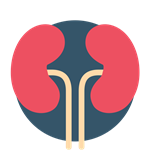
Diagnosing cystinosis
Diagnosis
Diagnosis of nephropathic cystinosis should be made as soon as possible, to facilitate prompt initiation of treatment and prevention of long-term complications.1
A diagnosis of cystinosis is usually made on the basis of patient presentation and the results of laboratory investigations, as summarised below.2
Investigations to support a diagnosis of cystinosis

White blood cell (WBC) cystine assay3
• The most common means to confirm diagnosis
• Cystine concentration is measured in preparations of mixed leukocytes or polymorphonuclear leukocytes

Slit-lamp examination2
Corneal cystine crystals are usually visible on a slit-lamp examination, and may be the initial diagnosing criterion for late-onset patients

Patient history and clinical symptoms1,2,4
• Failure to thrive
• Polyuria, polydipsia, vomiting, constipation
• Rickets
• Lighter skin and hair colour (a classic but not universal finding)

Laboratory tests1,4
• Serum electrolytes, protein, minerals, glucose
• Urinalysis to confirm and quantify renal glucose, protein, electrolyte, and mineral wasting

Other procedures2,4
• Imaging may help assess complications associated with cystinosis
• Renal or other tissue biopsy (rare)
• Genetic testing, while not required for diagnosis, may be useful to confirm diagnosis prior to treatment initiation and to characterise specific mutations
Explore the sections below to find out more.



Diagnosing cystinosis
Investigations required to support a diagnosis of cystinosis


